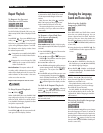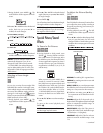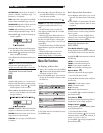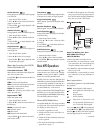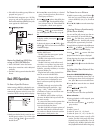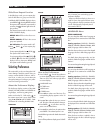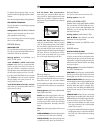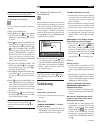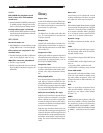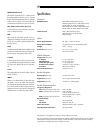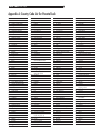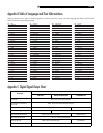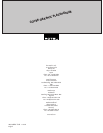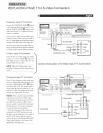
26
RDV-1040 DVD Player
Audio
DVD VIDEO disc playback sound
level is lower than TV broadcast
sound level.
• Set the D.RANGE CONTROL preference to
TV MODE (see the D. Range Control infor-
mation in the Preferences Setting section).
Analog audio output is distorted.
• Set the OUTPUT LEVEL preference to LOW
(see the Output Level information in the Pref-
erences Setting section).
MP3/WMA
No sound comes out.
• MP3/WMA disc is recorded with the “packet
writing (UDF format).” It cannot be played.
Files (tracks) are not played in the
recorded order.
• The RDV-1040 plays the files in alphabetic
order. So, the playback order can vary.
WMA files cannot be played back.
• The file is copy protected.
• The file is recorded with a bit rate under 48
kbps. The RDV-1040 does not support such
WMA files.
Glossary
Aspect ratio
A ratio which defines the shape of the rectan-
gular picture in a TV. It is the width of the pic-
ture relative to the height. A conventional TV
picture has 4:3 in aspect ratio.
Bitstream
The digital form of multichannel audio data
(e.g., 5.1-channel) before it is decoded into
its various channels.
Chapter/title
Chapter is the smallest division and title is the
largest division on DVD Video. A chapter is a
division of a title and similar to a track for Video
CD or Audio CD.
Component video
Video signals with three separate channels of
information that make up the picture. There are
several types of component video, such as
R/G/B and Y/CB(PB)/CR(PR).
Composite video
A single video signal commonly used in most
consumer video products that contains all lu-
minance, color, and synchronization informa-
tion.
Dolby Digital (AC3)
A six-channel system consisting of left, center,
right, left rear, right rear and LFE (Low-Fre-
quency Effect channel for use with a sub-woofer)
channels. All processing is done in the digital
domain. Not all Dolby Digital discs contain six
(5.1) channels of information.
Dolby Surround/Dolby Pro Logic
Dolby Surround records four channels of front
and rear audio in two channels in a way that
allows a decoder to recover the original four
channels for playback. Because the audio is
recorded in two channels, it can be played back
by a two-channel stereo system.
Dolby Pro Logic introduces directional circuits
in decoder-side processing (increasing the level
of specific channels and lowering the level of
silent channels) for greater spatial perspective,
and adds a center speaker used primarily for
dialog. The result is enhanced channel sepa-
ration.
Down-mix
Internal stereo mix of multichannel surround
audio by a DVD player. The down-mix signals
are output from stereo output connectors.
DTS
DTS stands for Digital Theater Systems, a Digital
Surround audio encoding format configured
with six (5.1) channels, similar to Dolby Digi-
tal. It requires a decoder, either in the player
or in an external receiver. Not all DTS discs
contain six (5.1) channels of information.
Dynamic range
The difference between the loudest and soft-
est sounds.
JPEG
A popular file format for still image compres-
sion and storage. JPEG stands for Joint Pho-
tographic Experts Group.
There are three sub-types of the JPEG format
as follows.
• baseline JPEG: used for digital cameras, the
web, etc.
• progressive JPEG: used for the web
•lossless JPEG: an old type, rarely used now
Linear PCM audio
PCM stands for “pulse code modulation.” Linear
PCM is the usual method for digitally encod-
ing audio without compression, and is used
for the audio tracks on DVD Video discs, Au-
dio CDs, etc.
MP3
MP3 is an audio data compression format,
which stands for MPEG-1 Audio Layer 3. Us-
ing MP3, you can achieve a data reduction
of about 1:10.
MPEG
MPEG stands for Moving Picture coding Ex-
perts Group. MPEG is a family of standards
for compressing audio-visual infromation.
“MPEG” standards include MPEG-1, MPEG-
2 and MPEG-4. Video CD and MP3 are based
on MPEG-1, while DVD is based on MPEG-
2.



